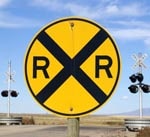 WASHINGTON – In a new report updating the industry’s progress on installing positive train control, the nation’s freight railroads said that a year-long moratorium on installing 20,000 communication antennas imposed by the Federal Communications Commission, followed by a lengthy federal approval process mandated by the agency, has seriously delayed the implementation of nationwide interoperable PTC. Whereas freight railroads once projected that by 2015 they would have PTC installed on 40 percent of the network mandated by FRA, they now believe thanks to the FCC issues only 20 percent of the PTC network will be up and running by the Congressionally imposed deadline.
WASHINGTON – In a new report updating the industry’s progress on installing positive train control, the nation’s freight railroads said that a year-long moratorium on installing 20,000 communication antennas imposed by the Federal Communications Commission, followed by a lengthy federal approval process mandated by the agency, has seriously delayed the implementation of nationwide interoperable PTC. Whereas freight railroads once projected that by 2015 they would have PTC installed on 40 percent of the network mandated by FRA, they now believe thanks to the FCC issues only 20 percent of the PTC network will be up and running by the Congressionally imposed deadline.
“Everyone in the industry is greatly frustrated at the inability to move forward and do what we need to do to advance PTC installation,” said Association of American Railroads President and CEO Edward R. Hamberger. “It’s been two steps forward, three steps back for months and we simply don’t have the certainty we need to move ahead and get PTC tested, fully functioning, certified and ready to go.”
Causing the timing for installation to be delayed significantly, Hamberger said, was an FCC directive to suspend installation of approximately 20,000 communications antennas necessary to for PTC to work until the antennas are assessed through the FCC’s environmental and historical evaluation process. The problem, Hamberger noted, is that how the thousands of antennas are to be reviewed has yet to be determined. The majority of the antennas at issue are between 10- to 60-feet tall, and roughly 97 percent are located on railroad property, he added.
The freight rail industry is expected to install PTC on approximately 60,000 miles of mainline track and has spent approximately $4 billion to date implementing the automatic braking system Congress called for as part of the 2008 Rail Safety Improvement Act.
AAR’s report to FRA summarizing the freight railroad industry’s progress, available here, includes an in-depth look at issues, such as delays in availability of critical back-office-server software, complexities of mapping an ever-changing nationwide rail network, and taking a phased approach to testing and implementing PTC on each railroad’s PTC network.
Hamberger noted that despite the challenges, railroads so far have been able to make progress in some areas of PTC implementation, including:
- Installing or partially installing PTC equipment on 50 percent of the locomotives on which it will be required;
- Deploying one third of the wayside units that will be required;
- Replacing half of the signals needed for implementation, and
- Mapping most of the track that will be equipped with PTC.
 WASHINGTON – The nation’s freight rail industry this week will outline for the Surface Transportation Board (STB) the various negative impacts of a proposal to force non-market based requirements on railroads at the request of the National Industrial Transportation League (NITL). The proposal calls for the STB to override market forces by forcing Class I railroads to turn over to their competitors substantial portions of rail traffic which moves across tracks they own and have spent billions to build, maintain, and upgrade so taxpayer’s don’t have to.
WASHINGTON – The nation’s freight rail industry this week will outline for the Surface Transportation Board (STB) the various negative impacts of a proposal to force non-market based requirements on railroads at the request of the National Industrial Transportation League (NITL). The proposal calls for the STB to override market forces by forcing Class I railroads to turn over to their competitors substantial portions of rail traffic which moves across tracks they own and have spent billions to build, maintain, and upgrade so taxpayer’s don’t have to. WASHINGTON – The nation’s freight railroads this year project they will spend approximately $26 billion to build, maintain, and upgrade their nationwide rail network, according to an estimate released March 12 by the Association of American Railroads. Railroads also expect to hire more than 12,000 people in 2014, for jobs throughout all areas of the industry and located all across the U.S.
WASHINGTON – The nation’s freight railroads this year project they will spend approximately $26 billion to build, maintain, and upgrade their nationwide rail network, according to an estimate released March 12 by the Association of American Railroads. Railroads also expect to hire more than 12,000 people in 2014, for jobs throughout all areas of the industry and located all across the U.S. WASHINGTON – The Association of American Railroads Nov. 14 urged the U.S. Department of Transportation to press for improved federal tank car regulations by requiring all tank cars used to transport flammable liquids to be retrofitted or phased out, and new cars built to more stringent standards. AAR said in comments filed with the Pipeline and Hazardous Materials Safety Administration (PHMSA) that the safety upgrades it is recommending will substantially decrease the likelihood of a release if a tank car is involved in an accident.
WASHINGTON – The Association of American Railroads Nov. 14 urged the U.S. Department of Transportation to press for improved federal tank car regulations by requiring all tank cars used to transport flammable liquids to be retrofitted or phased out, and new cars built to more stringent standards. AAR said in comments filed with the Pipeline and Hazardous Materials Safety Administration (PHMSA) that the safety upgrades it is recommending will substantially decrease the likelihood of a release if a tank car is involved in an accident.